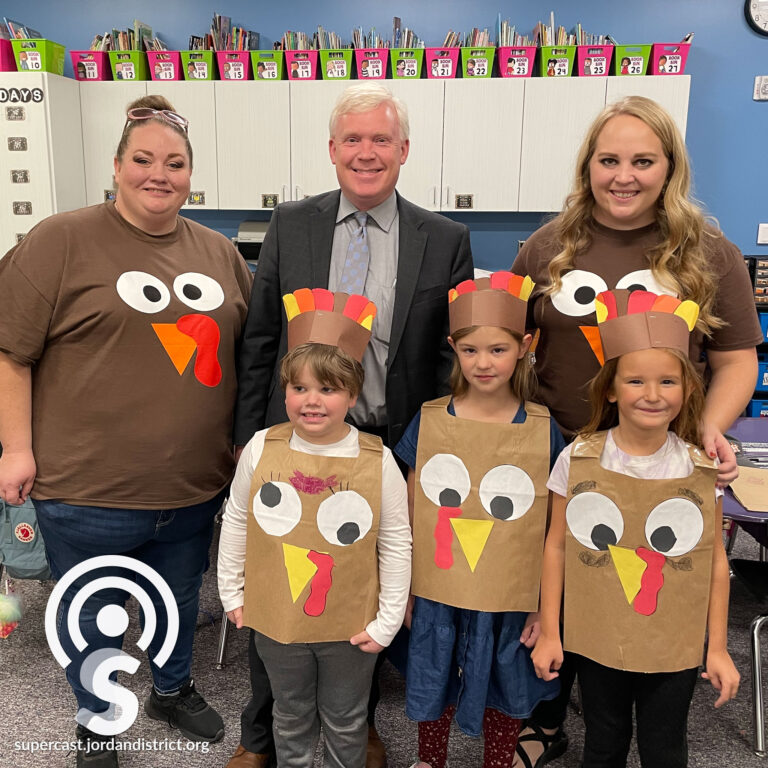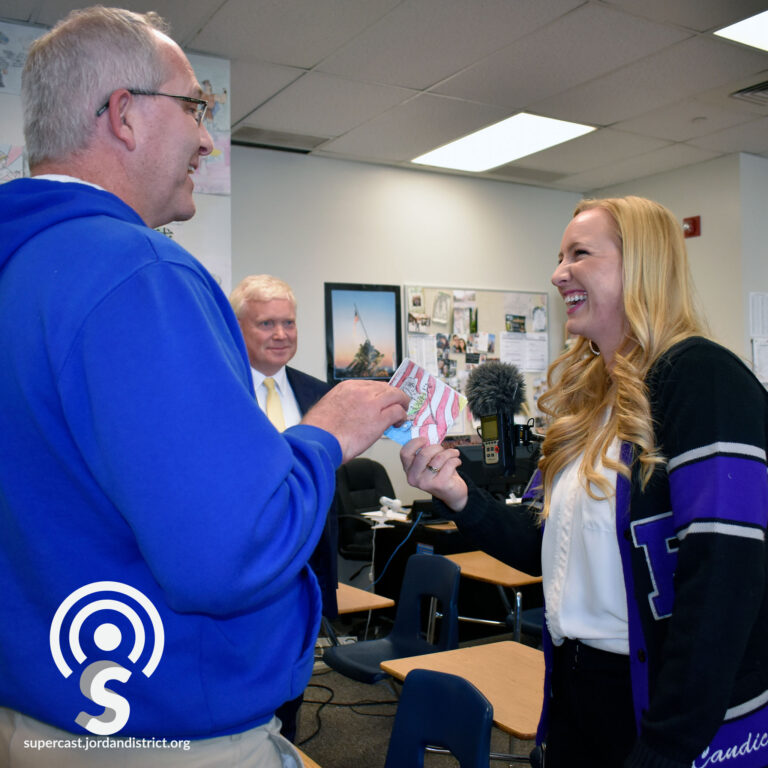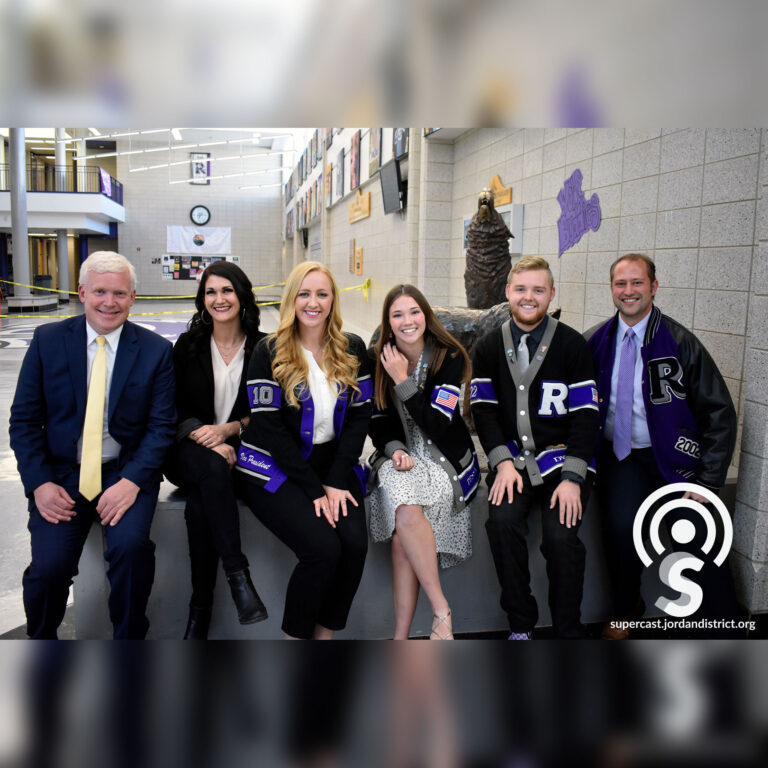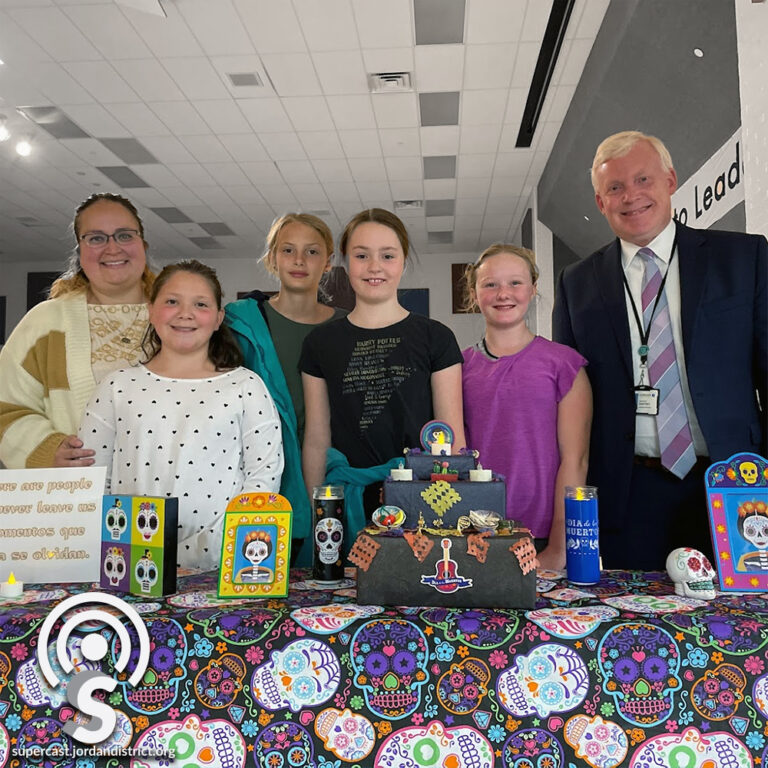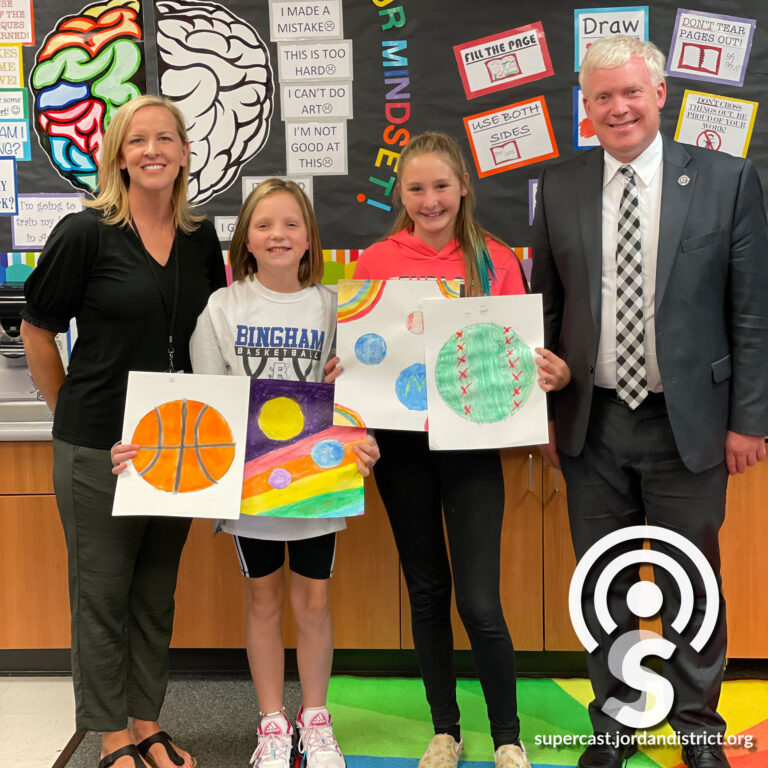It has been a beloved school and community Thanksgiving tradition at Golden Fields Elementary. On this episode of the Supercast, we find out why the Turkey Trot and Turkey Tunes play such an important role in the school’s Thanksgiving celebration year after year.
Then, we have some fun with students who show us their home-made talking turkeys and tell us what they are thankful for this year.
Audio Transcription
Anthony Godfrey:
Hello and welcome to the Supercast. I'm your host, Superintendent Anthony Godfrey. It has been a beloved school and community Thanksgiving tradition at Golden Fields Elementary for years. On this episode of the Supercast, we find out why the Turkey Trot and Turkey Tunes play such an important role in the school's Thanksgiving celebration year after year. Then we have some fun with students who show us their homemade talking turkeys and tell us what they're thankful for this year.
We're here in first grade at Golden Fields with Stephanie Murray and Amber Squire to talk turkey here before Thanksgiving. First off, you guys have amazing shirts on. Tell me about this.
Stephanie Murray:
Our whole program is based around the turkey and our first graders dress up in turkey costumes that they create themselves. So we couldn't just leave them hanging, we had to dress up as the turkey ourselves. So we reached out, purchased some shirts and surprised them this morning. When we walked out to pick them up, they almost lost it. They were so excited to see us sporting the turkey.
Anthony Godfrey:
So it's a brown shirt with big googly turkey eyes and a beak. And of course the
Stephanie Murray:
Snood.
Anthony Godfrey:
The snood. I knew you would know the word. That's why I could just pause, the snood. So you look very festive. Tell me how did the focus on turkeys get started?
Stephanie Murray:
Well, long ago, when we very first opened the school, we had so much fun during the month of October celebrating Halloween and all of its festivities. We had a bunch of fun during December celebrating all of the winter holidays, but November kind of got passed over. That had us a little sad because November is a very important month and a time to reflect on being thankful and showing gratitude for what we have and those around us. So we started thinking as a team, how can we make this month focused on what it truly is about being thankful to those around us? And so we started a search to find some child appropriate songs, and we wound up finding turkey. So our whole month has been spent talking about turkeys, learning everything we can about them, but also about why the turkeys are so grateful to escape being eaten on Thanksgiving day, if they're ever so lucky. We use that as a stepping stone to talk to the children about what they are thankful for and just had a lot of fun along the way, using the turkey as our guide.
Anthony Godfrey:
It's a great tie into the Thanksgiving meal and to turkeys, but also to have the kids reflect on their own lives and the things that they're grateful for. What a wonderful way to make November exciting for the students. That's really what it's about, connecting with students. I'm sure this is something they'll remember for a very long time.
Stephanie Murray:
Oh, definitely. We still have kids that are here the first year that we did it that come up to us and say, I still remember Turkey Tunes and I have my costume and everything. So we hope that it is something that leaves a lasting memory with them for the rest of their lives.
Anthony Godfrey:
Tell me something about the costumes. What do they put together?
Amber Squire:
For the costumes, we just use brown paper bags, like grocery bags. We cut them up the back and then we actually cut arm hold inside of them and a little neck hole for the collar. Then we have large white circles for the eyeballs and then black construction paper for pupils. And then we have beaks and snoods, and that's the vest. Then we actually have the children put those on and we take Velcro and secure it so it can fit to their bodies perfectly.
Stephanie Murray:
We do a lot of dancing in this show, so we don't want to lose our turkey bodies in the process.
Amber Squire:
And then on their heads we take brown construction paper and staple it together to make a headband. We put feathers in a pattern, so we do a brown feather in the center sticking up from the back of their heads and then red feathers, orange feathers, and yellow feathers on either side. It makes a little secure turkey, feather hat.
Stephanie Murray:
We shake our turkey feathers a lot also.
Anthony Godfrey:
Shake your turkey feathers. Okay.
Amber Squire:
Shake our turkey feathers and point our toes like it says in our last song.
Anthony Godfrey:
Oh, okay. Now do you two dance along with them?
Stephanie Murray:
More than you would ever want to see.
Amber Squire:
We always joke that we get our cardio in these days. For the whole month of November, that's our cardio.
Anthony Godfrey:
So has Turkey Tunes taken over maybe even some of the other holidays throughout the year, or is it just kind of hanging with the others now?
Stephanie Murray:
You know what, it has taken over I think. In October, you know, we have the typical fun, the Halloween parade and the Halloween party. But Turkey Tunes invites the families in, it invites the friends in, it invites the community in to stop, pause, reflect on what we're grateful for and have a little fun while we're at it. So it's something that everybody around us looks forward to.
Anthony Godfrey:
Oh, here they come. Here come some of the students to come in and get reconnected with their costumes here. Tell me your name.
Jonah:
Jonah.
Anthony Godfrey:
Hi, Jonah. What's your name?
Pierce:
Pierce.
Jocie:
Jocie.
Anthony Godfrey:
Pierce and Jocie. Tell us a little bit about what you're looking forward to today.
Jonah:
Being on the podcast.
Anthony Godfrey:
Yeah, it is exciting to be on a podcast.
Jonah:
I’ve already been on one before.
Anthony Godfrey:
Oh, have you really? Tell me about that?
Jonah:
I did one about Lego Mario.
Anthony Godfrey:
Lego Mario. Well, I have not yet talked about Lego Mario on my podcast, but it seems like maybe one day I should. And if I ever do, you'll be the first person I call. So tell me about today. Tell me about your performance.
Jocie:
Turkey Tunes. We do songs about turkeys.
Anthony Godfrey:
And is the word gobble in any of these?
Jonah:
Most of them.
Anthony Godfrey:
Most of them have the word gobble. That makes a lot of sense. Pierce, what's your favorite song today?
Pierce:
Glad I'm Not a Turkey.
Anthony Godfrey:
Glad I’m Not a Turkey. Well, I can probably guess, I'm pretty glad I'm not a turkey even without hearing the song. What's your favorite?
Jocie:
Um, Turkey Dance.
Anthony Godfrey:
Can you tell me what happens in the dance?
Jocie:
You have to say gobble and you have to wobble and you have to strut.
Anthony Godfrey:
So you, you say gobble and you wobble and you strut. That's a lot to remember. It's a good thing you guys have been practicing. Tell me about making your costumes. Was that fun?
Jonah:
Yeah, we used glue, staplers and scissors.
Anthony Godfrey:
Glue, staplers and scissors. Is this something that you're going to take home?
Jonah:
Yes, I mean no.
Anthony Godfrey:
No? No, you want to keep it here?
Jonah:
Yeah.
Anthony Godfrey:
Did they ask to hang it up? Because it was so good?
Jonah:
No, we have to use it in like 15 minutes.
Anthony Godfrey:
Oh, in 15 minutes you have to use it. But after that, are you going to take it home?
Jonah:
Yes.
Anthony Godfrey:
Yes. Okay. Are you guys going to wear this at Thanksgiving dinner?
Jocie:
Maybe.
Anthony Godfrey:
Maybe? Don't you think people would like it if you wore those feathers and you came in? Or would they feel uncomfortable eating turkey?
Jonah;
And there’s a turkey hat.
Anthony Godfrey:
Oh, there's a Turkey hat. Do you know where yours is? Can I get a look at that? Yeah. Oh, see, I thought the feathers would have gone at the front, but that doesn't make any sense. The way you're wearing it makes a lot of sense. You guys look really great in these costumes. I don't know, if I were you, I think you ought to be wearing them at dinner. I'm looking forward to the performance. Tell me what you're looking forward to most and Thanksgiving.
Jonah:
The main course.
Anthony Godfrey:
The turkey. Yes, you're very right. The turkey and the gravy. Do you put the gravy on the turkey? Yes. Okay. How about you? What are you looking forward to most?
Pierce:
Eating steak with my family.
Anthony Godfrey:
Eating steak?
Pierce:
Yeah, we usually have steak instead of turkey.
Anthony Godfrey:
So should you really be dressed up as a steak today?
Jonah:
We have a giant turkey in our fridge, by the way.
Anthony Godfrey:
You have a giant turkey in your fridge?
Jonah:
It's like the head’s gone and the organs are pulled out.
Anthony Godfrey:
The organs are pulled out and the head is gone. So you're well on your way,
Jonah:
And there’s seasoning on it.
Anthony Godfrey:
And there’s seasoning on it? Does it just gradually get closer? Like one day the insides are gone and the next day the seasonings on and it just kind of gradually moves forward. You've been paying close attention to this haven’t you? It's because you're looking forward to the turkey. Yes. So you have steak every Thanksgiving.
Pierce:
Yeah, usually.
Anthony Godfrey:
Do you call it steaks-giving?
Pierce:
No.
Anthony Godfrey:
No, you don't. Do you have Turkey and steak or just steak?
Pierce:
Steak.
Anthony Godfrey:
Okay. Is it cooked on the grill or out on the barbecue or how does your dad cook it?
Pierce:
Barbecue.
Anthony Godfrey:
Out on the barbecue.
Pierce:
My dad makes the best steak.
Anthony Godfrey:
Oh, wow. Is it kind of pink in the center? Yeah. Well, that sounds fantastic. What time should I come by for steak?
Pierce:
I don’t know.
Anthony Godfrey:
Just whenever I come by, there'll be steak cooking. Huh? Okay. What are you looking forward to?
Jocie:
The turkey.
Anthony Godfrey:
The turkey. Okay. Do you put gravy on your Turkey and have you been watching the turkey like Jonah?
Jocie:
I haven't got a turkey yet.
Anthony Godfrey:
Okay. Not yet.
Jonah:
In two days we have to eat Turkey and the Thanksgiving dinner. I'm counting Thanksgiving too.
Anthony Godfrey:
Okay. Two days until Thanksgiving, including Thanksgiving. Okay. Fair enough. So what do you think about the turkey? Have you named the turkey?
Jonah:
No, I want to, but I want to name him like gobbler.
Anthony Godfrey:
Gobbler. Okay. All right. All right. Tell me something you're thankful for that's not turkey and will not be on your table.
Jonah:
My dog.
Anthony Godfrey:
Your dog. Your dog is well behaved so he's not going to be on the table, right?
Jonah:
My dog's name is Archie. Archibald Nacio Gretsch.
Anthony Godfrey:
Oh, wow. That's a long name.
Jonah:
Nacio for nacho.
Anthony Godfrey:
Oh, okay. Very good. And so that's the middle name? Kind of? I definitely need to talk to you more. Okay. Tell me what you're thankful for?
Jocie:
My friends and family.
Anthony Godfrey:
Friends and family. Great. And what are you thankful for?
Pierce:
My class.
Anthony Godfrey:
Awesome.
Pierce:
And all the teachers in the school.
Anthony Godfrey:
Very good. I'm thankful for your class and all the teachers in the school too. That's really cool. Okay. Well, I hope you guys have a fantastic Thanksgiving and I can't wait for the performance. See you in a minute.
Stay with us. When we come back more about the Turkey Trot.
Break:
Are you looking for a job right now? Looking to work in a fun and supportive environment with great pay and a rewarding career? Jordan School District is hiring. We're currently filling full and part-time positions. You can work and make a difference in young life and education as a classroom assistant or a substitute teacher. Apply to work in one of our school cafeterias where our lunch staff serves up big smiles with great food every day. We're also looking to hire custodians and bus drivers. In Jordan School District we like to say people come for the job and enjoy the adventure. Apply today at workatjordan.org
Anthony Godfrey:
We're here with Carolyn Dailey, 2nd grade teacher at Golden Fields. She's going to talk to us about the Turkey Trot happening today. What is that?
Carolyn Dailey:
So our Turkey trot is a fun way to get the kids enthused about Thanksgiving and we create turkey hats. They become little turkeys themselves. And then we create a little gobbler made out of a cup to bell the sound of the gobbler gobbling. We just have a little trot parade around the school and out the door to Thanksgiving.
Anthony Godfrey:
And the kids look forward to this, I have no doubt.
Carolyn Dailey:
It's become quite the tradition.
Anthony Godfrey:
So this is your own mini Golden Fields Thanksgiving Day Parade, I suppose. How long has this been going on?
Carolyn Dailey:
So actually we brought the tradition to Golden Fields when we opened. So it's been here the entire time the school has been here.
Anthony Godfrey:
Wow. So do kids in 1st grade look forward to their 2nd grade where they get to graduate to the parade from the Turkey Tunes?
Carolyn Dailey:
You bet.
Anthony Godfrey:
And so they create their own costume. Tell me again, what's involved in making the gobbler?
Carolyn Dailey:
So the gobbler’s the best part of the Turkey Trot. This is what the kids really look forward to. So you take a cup, it can be any cup that you want to do, that's disposable. You put a little hole in the bottom of the cup and invert it. So it has the bell effect of making the sound a little bit louder. And then you're going to insert a string and tie it up on the top with a paperclip. And then at the bottom of the string, you're going to tie a little piece of sponge. And then we make the little cup look like a Turkey as well. Then at the time of the parade, we dampen the sponge and then you pull. Take the sponge and wrap it around the string and jerk it down. It makes a clucking sound and the bell magnifies that sound. So they're just clucking away on their parade.
Anthony Godfrey:
Have they practiced on this?
Carolyn Dailey:
That's the best part ,the practice.
Anthony Godfrey:
Can I get a look at one?
Carolyn Dailey:
Absolutely!
Anthony Godfrey:
All right, let's go take a look.
Carolyn Dailey:
Here's our gobbler.
Anthony Godfrey:
Okay. Let's see. This Turkey looks particularly happy. Okay. So we've got feathers on top of the cup and then a paperclip. Okay. I see the paper beak is sticking out. So that is just wet sponge being pulled down a string and amplified by the cup. Can I try it? I have never gobbled like this before. All right. Let's see if you guys think I can do it. Okay. All right. Let me give it a shot.
All right. That is really cool. I am making gobblers at home this year. I am telling you that right now. I have to do it again, I can't resist. How many of you guys hear the sound in your sleep? Yes, I see most of you do. Wow. That is really cool. Well, congratulations. I've been through 51 Thanksgivings, and I know it's pretty remarkable. Well, I'm 52. This is going to be 52 Thanksgivings. I just haven't been through that one yet. I know it's surprising because I look so young. Right. See, thanks for the thumbs up buddy. But yeah, this is, I can't get enough of it. You guys just like want to do it all the time? I totally understand. I like your shirt. It has a Turkey that says eat pizza and he's in a disguise. Well done.
Tell me how these gobblers came to be.
Carolyn Dailey:
Years ago, it was probably 20 years ago when my kids were little, we were having Thanksgiving and their cousins had made one at school. So of course, being a teacher myself, I was like, let's check this out. And we saw how they constructed these gobblers. So of course I had to continue the tradition.
Anthony Godfrey:
Well, you guys are awesome. Well, have a lot of fun with your Turkey Trot and your gobblers.
Carolyn Dailey:
Keep that one as a memento of your visit.
Anthony Godfrey:
Really? Are you serious? I get to keep the gobbler. Oh man, I'm going to be the most popular guy at Thanksgiving dinner.
Carolyn Dailey:
Should we give him a ceremonial turkey hat to take too?
Anthony Godfrey:
Wow. Thank you very much for letting me visit. I hope you all have a very happy Thanksgiving.
Thanks for joining us on another episode of the Supercast. Remember education is the most important thing you'll do today. We'll see out there.

